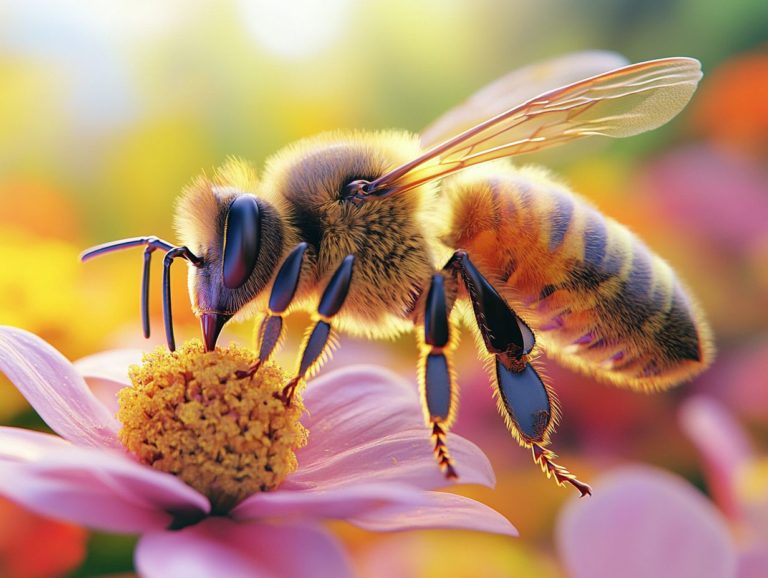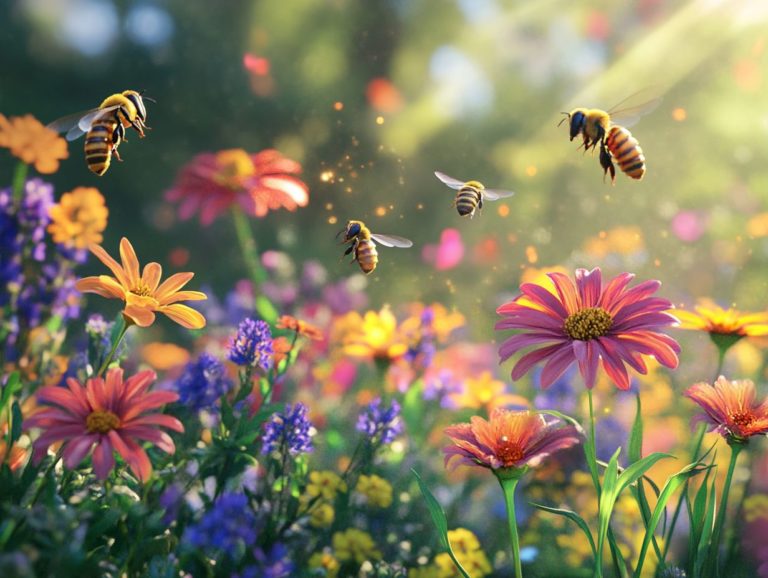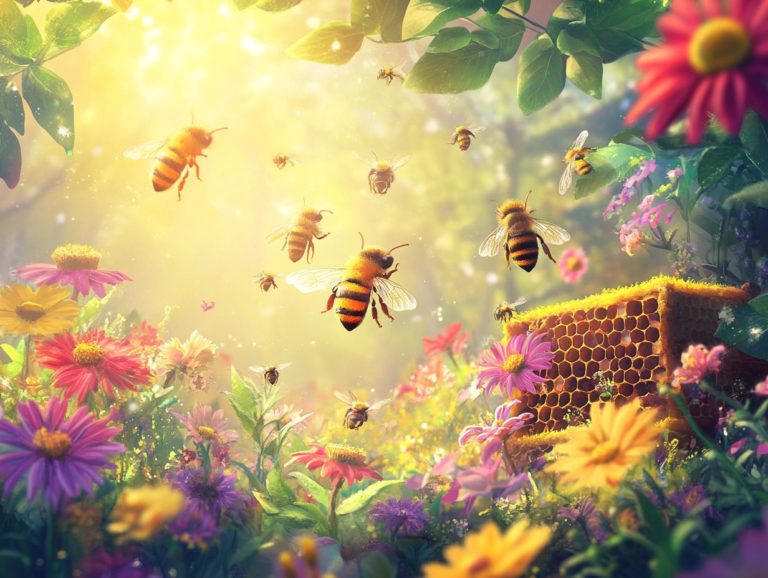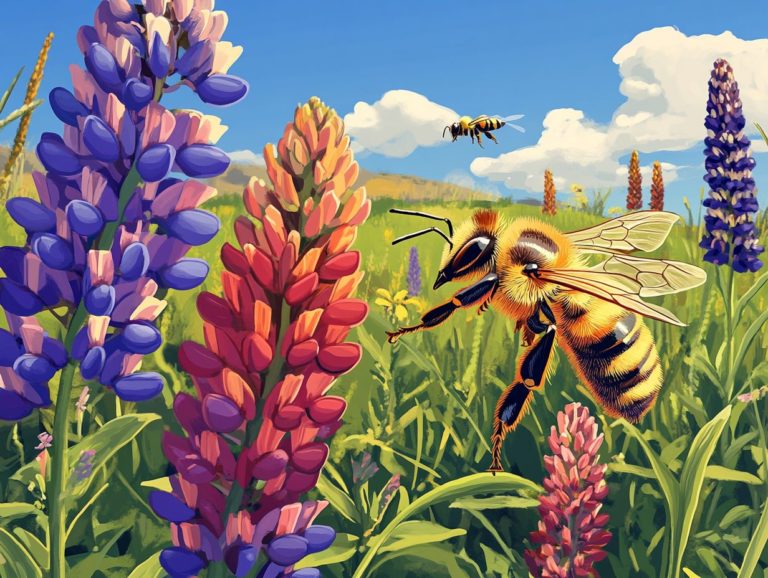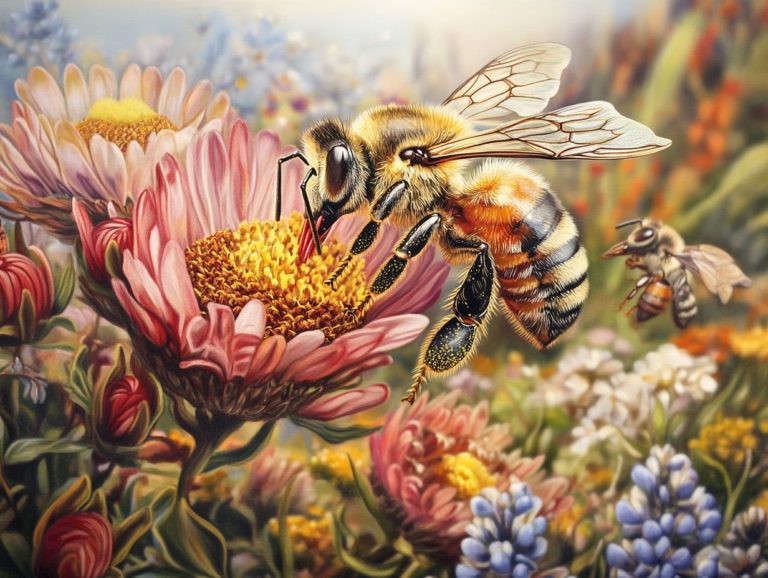Exploring Solitary Bees and Their Habits
Solitary bees are truly remarkable creatures that play an important role in our ecosystem, yet they often escape your notice. There are numerous bee species, including solitary bees, that contribute significantly to pollination.
Unlike their social counterparts, these bees build their own nests in different ways and encompass a diverse range of species, each contributing to the health of your gardens and natural landscapes. From the industrious mason bees to the diligent leafcutter bees and mining bees, each female solitary bee creates her own nest using natural materials, enhancing your garden environment.
In this article, you’ll discover the differences between solitary and social bees, introduce you to various types of solitary bees, including the Yellow Loosestrife Bee, Wool Carder Bee, and Chocolate Mining Bee, and discuss their habitats, diets, and reproductive habits.
You ll also find valuable tips on attracting these essential pollinators to your garden, enhancing both its biodiversity and aesthetic appeal. Learn how to provide nesting materials and create bee hotels to support solitary bee populations.
Join in the exploration of the fascinating world of solitary bees and appreciate their critical importance to our environment.
Experts like Charlotte Rankin from the NHSN Invertebrate Section and Dave Hunter from Crown Bees emphasize the importance of solitary bees. The Xerces Society also offers valuable resources for bee conservation efforts.
Contents
- Key Takeaways:
- What Are Solitary Bees?
- What Is the Difference Between Solitary Bees and Social Bees?
- What Are the Different Types of Solitary Bees?
- Where Do Solitary Bees Live?
- How Do Solitary Bees Reproduce?
- What Do Solitary Bees Eat?
- Why Are Solitary Bees Important for Our Ecosystem?
- How Can You Attract Solitary Bees to Your Garden?
- Frequently Asked Questions
- What are solitary bees and where do they live?
- What is the difference between solitary bees and social bees like honeybees?
- How do solitary bees differ from other types of bees like honeybees and bumblebees?
- Where can I find solitary bees and learn about their nesting habits?
- What are the benefits of exploring solitary bees, their habits, and the solitary bee lifecycle?
- How can I attract solitary bees to my garden and support bee conservation?
Key Takeaways:
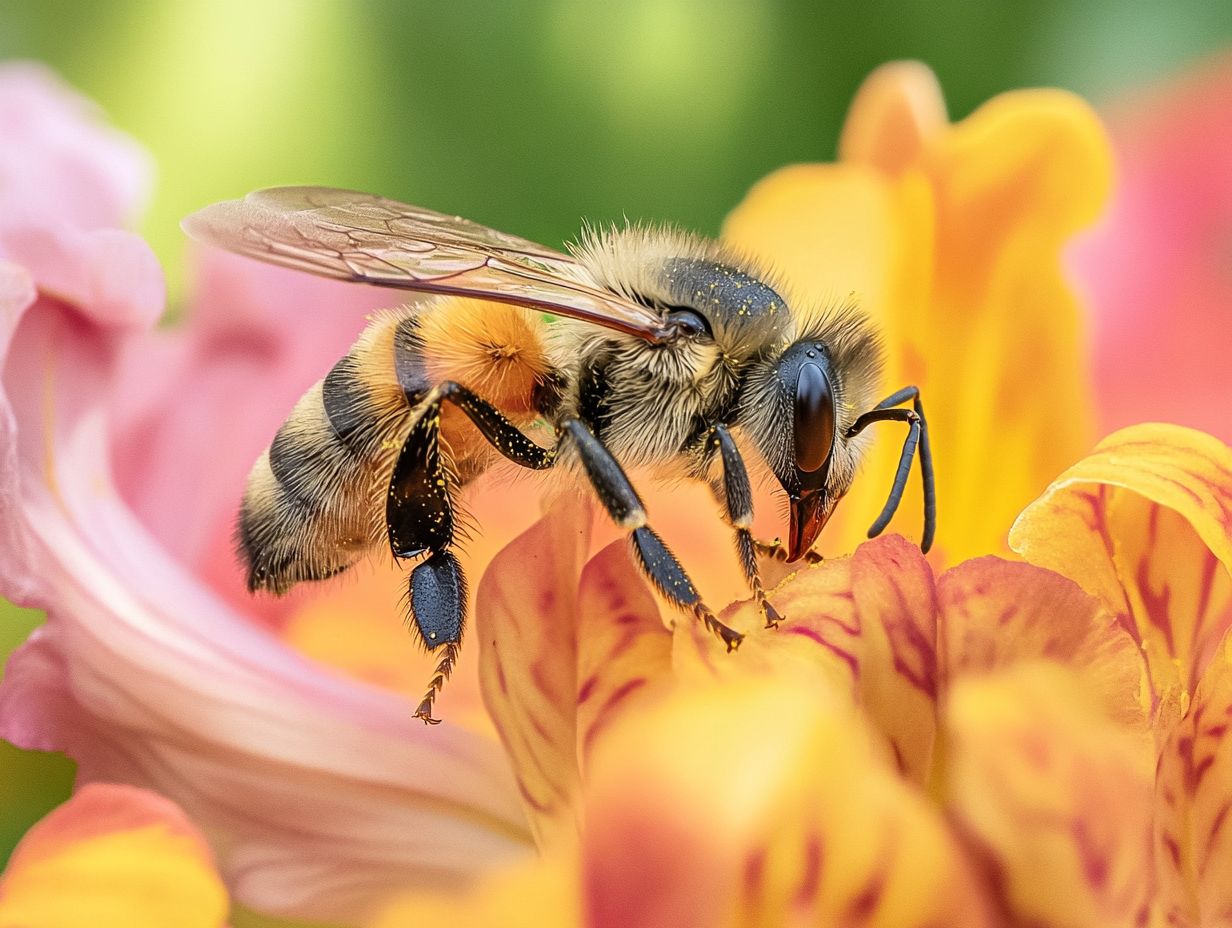
- Solitary bees are important pollinators for many plants and crops, including fruits and vegetables.
- Unlike social bees, solitary bees do not live in hives; each female creates her own nest.
- To attract solitary bees to your garden, plant native flowers, provide nesting materials, and avoid pesticides.
What Are Solitary Bees?
Solitary bees are captivating insects that set themselves apart from their more well-known relatives, like honeybees and bumblebees. Unlike social bees that thrive in colonies, solitary bees such as mason bees, mining bees, and leafcutter bees flourish independently, with each female diligently constructing her own nest.
These remarkable creatures play a vital role in pollination, significantly enhancing the ecosystem by supporting the growth of various pollen sources, especially in the Northeast regions of North America. By diving into their nesting habits and lifecycle, you can gain valuable insights that are essential for promoting solitary bee populations and advancing conservation efforts.
What Is the Difference Between Solitary Bees and Social Bees?
The primary distinction between solitary bees and social bees lies in their social structure and nesting habits. Solitary bees, like mining bees and leafcutter bees, operate independently. Each female is responsible for her own nest and offspring, often laying eggs in intricate nesting habitats.
In contrast, social bees, such as honeybees and bumblebees, thrive in organized colonies with a clear division of labor among members, including a queen, workers, and drones.
Take the mason bee, for example. Females craft individual nests in pre-existing cavities, diligently collecting pollen and nectar to provision each egg they lay. On the other hand, social bees exhibit truly fascinating behaviors. Honeybees, for instance, communicate through intricate dances to share vital information about food sources, showcasing a complex social dynamic that s nothing short of remarkable.
Both solitary and social bees experience similar life cycles, starting as eggs and progressing through larval and pupal stages. While solitary bees typically have a shorter active season, social bees, especially in temperate regions, build colonies that thrive through seasonal changes, demonstrating impressive resilience and teamwork.
What Are the Different Types of Solitary Bees?
Solitary bees represent a captivating array of species, each exhibiting distinct characteristics and behaviors that set them apart from their more social relatives.
Notably, mason bees stand out for their unique nesting practices, often ingeniously using natural materials. Leafcutter bees capture attention with their remarkable leaf-cutting abilities. Mining bees skillfully excavate ground nests, and carpenter bees, with their impressive wood-boring prowess, show this diversity. Species such as the Chocolate Mining Bee and the Wool Carder Bee add to the rich variety of solitary bees.
These variations not only underscore the remarkable adaptability of solitary bees but also highlight their crucial ecological role across different habitats.
1. Mason Bees
Mason bees represent a remarkable group of solitary bees, distinguished by their extraordinary nesting habits. They utilize natural materials such as mud and plant fibers to craft their nests within pre-existing cavities or crevices. This unique behavior significantly enhances pollination, making them essential for various flowering plants and pivotal in bee conservation efforts.
You might find them nesting in hollow stems, bee boxes, or even in the cracks of wooden fences. This illustrates their impressive adaptability to diverse habitats. Unlike social bees, mason bees thrive independently, which enables them to navigate their foraging territories with remarkable efficiency. They help in pollination, which supports the reproduction of wild plants and boosts the variety of plants and animals.
As climate change poses a growing threat to bee populations, understanding their life cycle and nesting preferences is crucial for saving these important pollinators! This knowledge is vital for developing effective conservation strategies, ensuring that these vital pollinators continue to flourish in their natural environments.
2. Leafcutter Bees
Leafcutter bees are remarkable solitary bees, renowned for their fascinating behavior of cutting leaves and petals to construct their nests, often nestled in tunnels or cavities. This distinctive nesting approach enables them to create protective chambers for their larvae, using the very plant materials they gather. In doing so, they play a crucial role as pollinators for numerous flowering plants, significantly contributing to the overall health of the ecosystem.
These industrious bees typically prefer soft, pliable leaves from a variety of flowering plants, such as clover and rose. They skillfully carve these leaves into small circular pieces. Once they’ve gathered their materials, they meticulously line their nests with these cuttings, crafting a cozy sanctuary for their offspring. The Yellow Loosestrife Bee is another fascinating example of a leaf-cutting solitary bee.
Their role as pollinators is vital for plants that rely on them for reproduction, enhancing not only floral diversity but also boosting crop yields.
As they forage, leafcutter bees inadvertently transport pollen, facilitating the essential cross-pollination the process where pollen from one flower fertilizes another flower, which is essential for many plants to grow fruit or seeds required for robust plant growth. This process ultimately supports a balanced ecosystem, benefiting human agriculture in the process.
Let s protect these amazing pollinators to ensure our gardens and wild spaces thrive!
3. Mining Bees
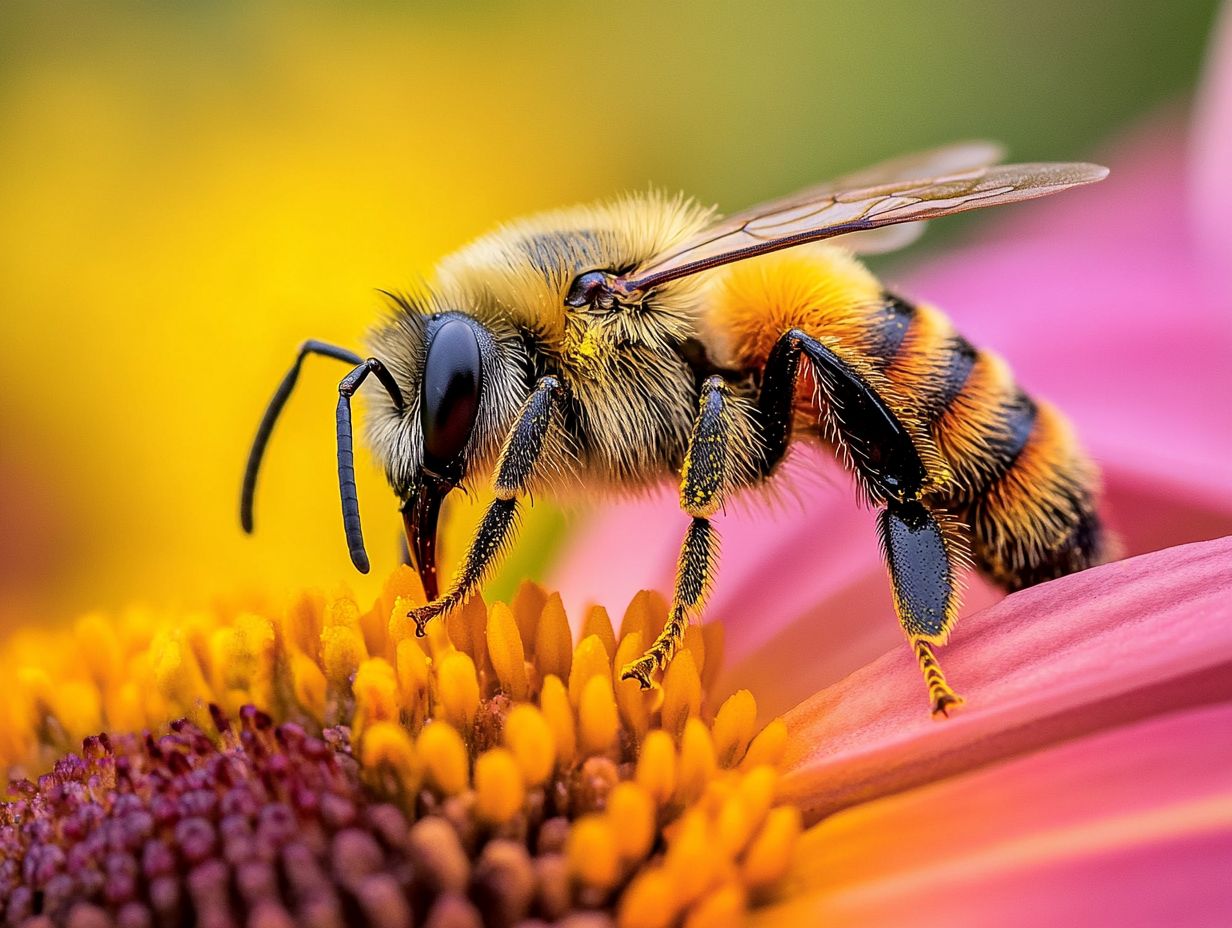
Mining bees represent a fascinating group of solitary bees that uniquely nest underground, setting them apart from other solitary species. These industrious ground-nesters excavate individual burrows in sandy or loose soil, where they lay their eggs. Their underground habitats are vital for their lifecycle, as the bees depend on various flower pollen to nourish their offspring. A specific species to note is the Chocolate Mining Bee, which showcases unique adaptations to its environment.
You ll often recognize these remarkable insects by their robust bodies and a striking array of colors that help them blend seamlessly into their soil environment. Mining bees are essential to our ecosystem, not just for their pollination efforts but also for their contributions to soil health. As they nest, they aerate the soil, enhancing its structure and promoting fertility. Their preferences for specific flowering plants bolster diverse ecosystems.
Come spring and early summer, these bees emerge to forage, diligently collecting valuable nutrients from flowers and returning them to their nests. This crucial activity not only supports plant reproduction but also sustains our ecosystems!
4. Carpenter Bees
Carpenter bees are fascinating solitary bees known for their distinctive wood-boring behavior. They carve out tunnels in dead or decaying wood to create their nests. This habit not only provides a home for their larvae but also aids in the decomposition of wood, enriching nutrient cycling in their environments.
These fascinating insects love to carve into softwoods like cedar, pine, and spruce, often choosing weathered or damaged wood for their tunneling endeavors. Their ecological impact goes beyond just nesting; as they pollinate a diverse array of flowering plants, carpenter bees play a vital role in maintaining the health of ecosystems. By visiting flowers in pursuit of nectar, they help facilitate plant reproduction, ultimately supporting biodiversity.
What s truly remarkable is that their solitary lifestyle doesn t diminish their productivity. Each female can influence a significant number of plants within her territory. Understanding the lives of these extraordinary bees is essential for recognizing their contributions to both natural and managed landscapes.
Where Do Solitary Bees Live?
The homes of solitary bees are as diverse as their species! Solitary bees flourish in an array of habitats, from charming gardens and lush meadows to serene forests and bustling urban landscapes, each presenting unique nesting opportunities for these essential pollinators. Understanding bee habitat preferences is crucial for conservation efforts.
Their varied nesting behaviors include ground-nesters, like mining bees that excavate burrows in the soil, and bees that build nests above ground, such as mason bees that take advantage of hollow reeds or pre-existing cavities. This adaptability allows them to thrive in diverse environments.
1. Nesting Habits
Solitary bees exhibit diverse nesting habits, including both ground-nesters and aerial nesters. This adaptability allows them to thrive in various environments, supporting pollination and biodiversity.
Nesting habits among solitary bees exhibit a remarkable diversity, showcasing their adaptability to various environments. If you observe ground-nesting species, like mining bees, you’ll see how they dig burrows directly into the soil. On the other hand, aerial nesting species, such as mason bees, cleverly utilize hollow stems or decaying wood to create protective chambers for their eggs. This variety reflects the unique habitats these bees occupy.
These nesting choices are not merely about safety; they directly impact their success as pollinators. For example, bees that select flower patches for nesting play a vital role in thriving ecosystems by ensuring effective pollination of plants.
The availability of suitable nesting sites whether it’s sandy soils or decaying wood is crucial for their lifecycle. Since different solitary bee species have distinct habitat preferences, understanding and conserving these environments is essential. If adequate nesting sites become scarce, the survival of specific species could be at risk, ultimately jeopardizing their crucial role in pollination and the overall health of ecosystems.
2. Preferred Nesting Materials
Solitary bees display a fascinating array of preferences when it comes to nesting materials, with choices that often hinge on their species and habitat. For instance, Mason Bees have a penchant for natural materials like mud and plant fibers, while Leafcutter Bees are on the hunt for leaves and petals to construct their nests. This incredible variety of nesting habits highlights just how vital each bee species is to our environment and underscores the critical importance of providing suitable nesting materials in your conservation efforts.
Take the Miner Bee, for example; it prefers burrowing into bare soil, crafting chambers for its offspring from the earth itself. This diversity in nesting behavior illuminates the ecological significance of varied habitats, as each type of nest plays a vital role in sustaining local ecosystems.
To support solitary bees and boost their chances of survival, you can create bee hotels using materials like bamboo and untreated wood, effectively mimicking their natural habitats. By incorporating native plants into your garden, you further encourage these valuable pollinators, ultimately contributing to habitat preservation and fostering a vibrant environment for both bees and other wildlife. Join us in protecting these amazing bees by planting native flowers in your garden!
How Do Solitary Bees Reproduce?
Reproduction among solitary bees is a captivating process that stands in stark contrast to the communal breeding observed in social bees. In solitary species, females typically mate with males and then craft their nests, laying eggs and often providing each one with a generous supply of pollen and nectar to ensure the larvae s survival. This showcases the unique traits of the solitary bee lifecycle.
Such meticulous preparation underscores the natural instinct of these bees to equip the next generation with the essential resources for growth. After mating, a female often creates multiple nests, each dedicated to a single egg. The level of care she exhibits is truly remarkable; she gathers materials like mud or plant fibers to seal her nests, shielding her young from predators and environmental threats.
Grasping these reproductive behaviors is vital for conservationists. Changes in habitat or resource availability can significantly disrupt the lifecycle of solitary bees and affect their populations. This highlights the critical need for informed environmental stewardship to ensure their survival.
What Do Solitary Bees Eat?
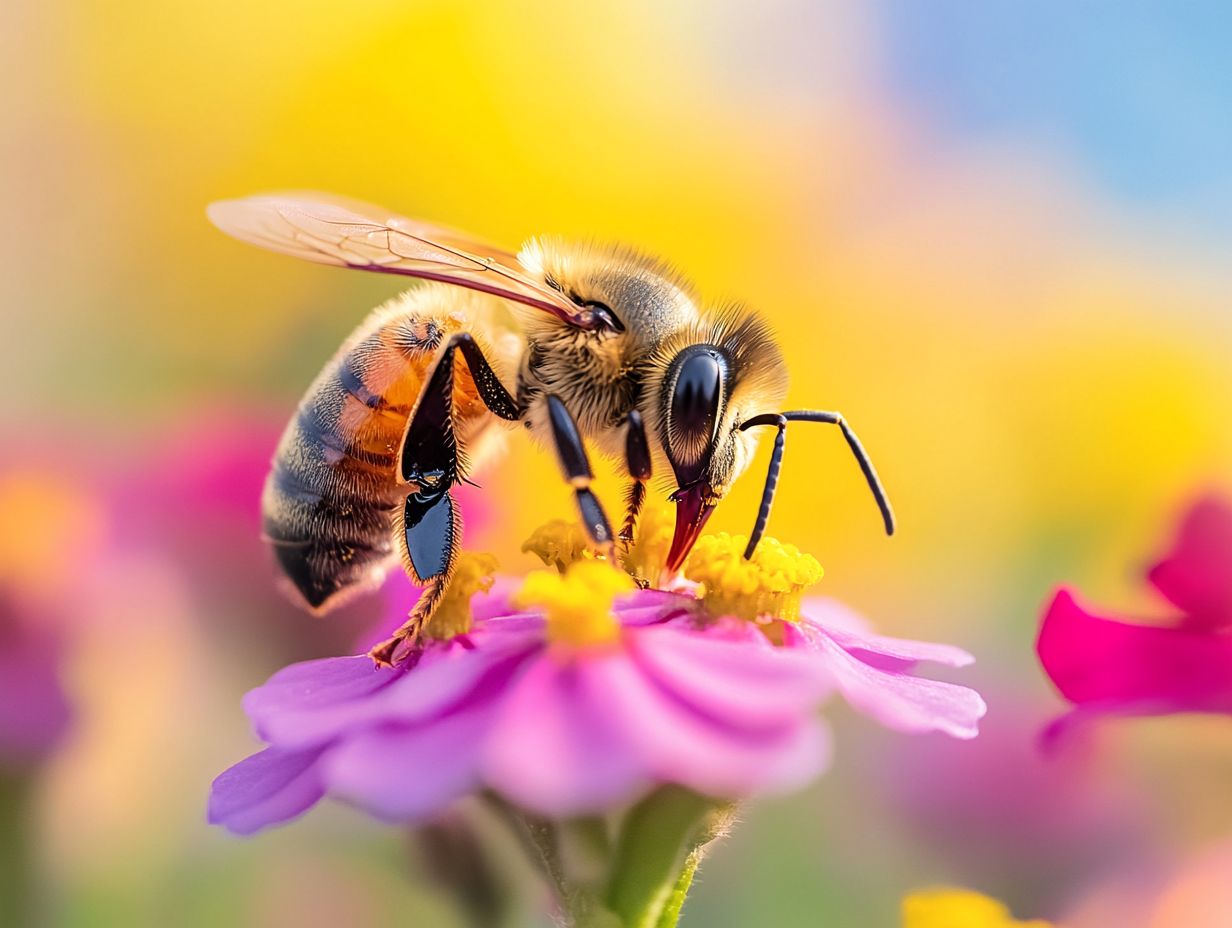
Solitary bees primarily rely on nectar and pollen, the cornerstone of their diet throughout their lives. These vital nutrients not only fuel their energy requirements but also serve a critical function in their reproduction and survival.
They also significantly contribute to the health of ecosystems, supporting a variety of flowering plants that depend on these bees for effective pollination. Understanding their diet is essential for ensuring their well-being.
1. Pollen Collection and Storage
Pollen collection is an essential activity for solitary bees, serving not just as their food source but also as a crucial support for their larvae’s growth. You’ll notice these remarkable creatures displaying a range of foraging behaviors as they collect pollen from various flowering plants.
They transport this precious cargo back to their nests, where it is skillfully stored alongside nectar, ensuring that their offspring have ample nourishment once they hatch.
Their foraging strategies often involve visiting multiple blossoms within a single plant species, allowing them to gather a significant amount of pollen in a relatively short time. Solitary bees instinctively choose a diverse array of plants, which is vital not only for their own health but for maintaining the delicate balance of ecosystems.
This diversity of pollen sources does wonders for promoting genetic variation among plants, bolstering their resilience against diseases and environmental shifts. As solitary bees engage in cross-pollination, they play a pivotal role in enhancing plant health, reinforcing the intricate connections within food webs and nurturing a vibrant natural environment.
Understanding these crucial roles reinforces the need for us to protect solitary bees and their habitats for future generations. What can you do to help preserve these incredible pollinators?
2. Nectar Collection and Consumption
Nectar collection is essential to your solitary bees foraging activities, providing them with the sugars they need to maintain their energy levels. These remarkable little workers visit a diverse array of flowers, using their specialized mouthparts to extract nectar. In doing so, they not only fuel their own survival but also contribute significantly to pollination, which is vital for the health of their ecosystems.
By targeting specific flower species that offer the most abundant and easily accessible nectar, solitary bees exhibit foraging behaviors finely tuned for maximum efficiency. This selective process not only meets their nutritional needs but also nurtures a relationship where both the bees and plants benefit, ultimately promoting genetic diversity. As these bees flit from bloom to bloom, their unintentional transfer of pollen enhances plant reproduction.
The intricate interplay between solitary bees and their chosen floral sources highlights the critical role they play in sustaining resilient ecosystems rich in biodiversity. Your understanding of these processes deepens your appreciation for nature s interconnectedness and illuminates the importance of preserving these vital relationships.
Why Are Solitary Bees Important for Our Ecosystem?
The significance of solitary bees in the ecosystem is profound, as they fulfill an essential role in the intricate dance of pollination that supports biodiversity and food production.
When solitary bees pollinate a wide range of flowering plants, they boost food production and biodiversity. This makes the conservation of these remarkable bees not just important, but vital for preserving the delicate balance of our environment.
How Can You Attract Solitary Bees to Your Garden?
Welcoming solitary bees to your garden is not just rewarding it’s essential for a thriving ecosystem! These vital pollinators enhance the health of your plants and support the local environment.
To cultivate a welcoming haven for solitary bees, incorporate native flowers that offer an abundance of nectar and pollen. Provide suitable nesting materials to help solitary bees thrive in your garden.
1. Planting Native Flowers
Planting native flowers is a great way to attract solitary bees to your garden! These plants serve as vital nectar sources that cater specifically to local bee species. Incorporating a variety of flowering plants that bloom at different times throughout the growing season creates a diverse habitat meeting the needs of solitary bees while enhancing your garden’s overall ecological health.
Consider including plants like coneflower (Echinacea) and black-eyed Susan (Rudbeckia). These hardy flowers bloom from summer to fall, ensuring bees have a steady food supply when other flowers are scarce.
Incorporating native wildflowers such as milkweed (Asclepias) is essential, as they attract not only bees but also butterflies. This plays a crucial role in maintaining healthy pollinator populations. The presence of these native plants fosters a balanced ecosystem, promoting biodiversity and improving soil health while creating a supportive environment for solitary bees to thrive.
2. Providing Nesting Materials
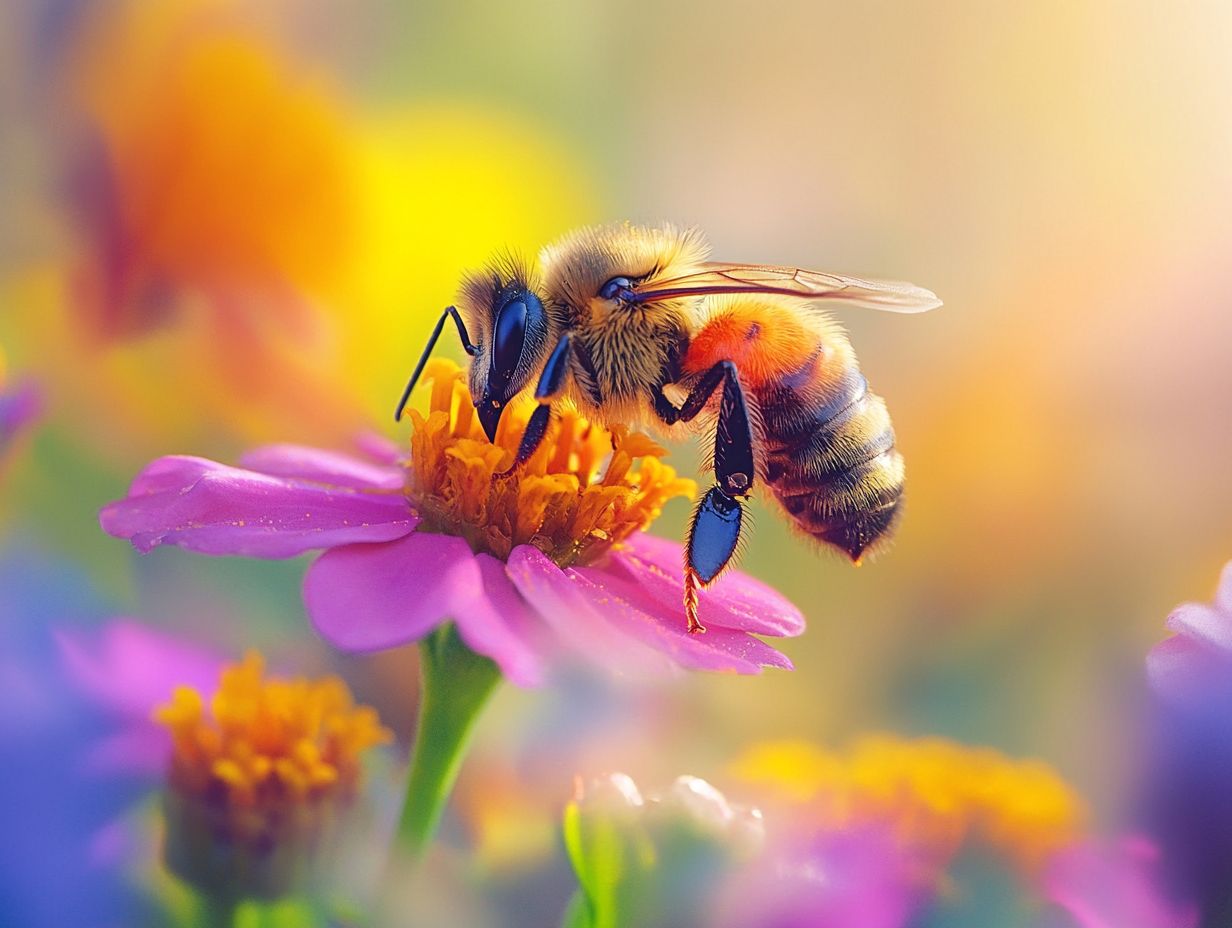
Providing nesting materials is essential for attracting solitary bees to your garden. These bees need appropriate habitats to lay their eggs and nurture their young.
By creating bee hotels or incorporating natural materials like mud, straw, and hollow twigs, you can offer vital nesting sites. This helps conserve solitary bee populations.
Building a bee hotel is not only simple but also a rewarding project that benefits local ecosystems. To get started, use untreated wood and drill holes of various diameters to cater to the diverse needs of different species. You might also consider filling wooden boxes with natural materials such as dried leaves or hollow stems.
You can install a mud puddle nearby to provide essential resources for the bees that need mud to seal their nests. These actions not only boost your garden’s biodiversity but also raise awareness about the crucial role solitary bees play in pollination, food production, and the broader solitary bee lifecycle.
3. Avoiding Pesticides
Avoiding pesticides in your garden is a vital step in creating a safe space for solitary bees, as these chemicals can seriously harm their health and diminish their populations. By using natural gardening methods and natural pest control methods, you protect these crucial pollinators, including ground-nesters and aerial nesters, and contribute to a flourishing garden ecosystem.
The repercussions of pesticides extend far beyond solitary bees; they can disrupt the delicate balance of entire habitats, impacting not only pollinators but also a host of other beneficial organisms. It s essential to understand that solitary bees are not just important for pollination; they also play a significant role in our food systems and biodiversity, affecting the availability of fruits and vegetables.
By implementing strategies like companion planting (growing different plants together to enhance growth), attracting natural predators, and using barriers to thwart pest infestations, you can cultivate an environment that encourages thriving bee populations. Creating pesticide-free zones not only supports solitary bees but also enhances the overall health of your garden by promoting a more resilient ecosystem and attracting various bee species, including mason bees and leafcutter bees.
In essence, prioritizing safe pest control methods benefits the bees, including female solitary and male solitary bees, and enables you to achieve your vision of a sustainable and vibrant landscape. Act now to protect these vital pollinators and create a vibrant garden ecosystem!
Frequently Asked Questions
What are solitary bees and where do they live?
Solitary bees live alone and do not form colonies like honeybees do. They are important pollinators and can be found in various habitats around the world, such as gardens, parks, and fields.
Social bees, such as honeybees and bumblebees, live in large colonies with a queen and worker bees, while solitary bees live alone and do not have a queen or organized colony structure.
How do solitary bees differ from other types of bees like honeybees and bumblebees?
Solitary bees have distinct physical characteristics, such as a larger head and smaller body, as well as different behaviors, such as nesting alone and not producing honey or wax. They rely on nectar and pollen sources for nourishment.
Where can I find solitary bees and learn about their nesting habits?
Solitary bees can be found in a variety of habitats, including gardens, parks, and fields. They often nest in pre-existing holes or burrow into the ground. Some common types of solitary bees include mason bees, leafcutter bees, and mining bees.
What are the benefits of exploring solitary bees, their habits, and the solitary bee lifecycle?
By learning about solitary bees and their habits, we can better understand their role in pollination and how to support their populations. Additionally, exploring solitary bees can be a fun and educational activity for all ages, shedding light on their pollination work and importance to ecosystems.
How can I attract solitary bees to my garden and support bee conservation?
Create homes for solitary bees by using bee houses or leaving bare patches of soil for them to dig into.
Plant a variety of flowers; this will surely attract these vital pollinators.
Adding natural materials and bee hotels can create a welcoming habitat for bees.
Start transforming your garden today and support bee conservation!

